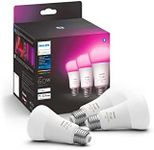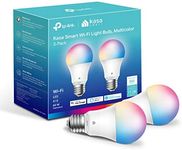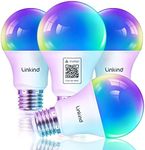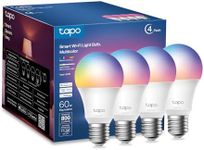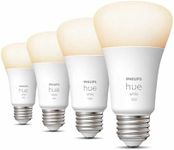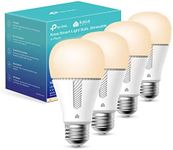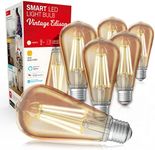Buying Guide for the Best Smart Bulbs For Google Home
Choosing the right smart bulb for your Google Home setup can make your home more comfortable, energy-efficient, and fun to use. The key is to find a bulb that works smoothly with your Google Home, fits your lighting needs, and is easy to control. Before buying, think about where you want to use the bulb, what kind of light you prefer, and how much control you want over brightness and color. Understanding the main features will help you pick a bulb that matches your lifestyle and makes your smart home experience enjoyable.Compatibility with Google HomeThis spec tells you whether the smart bulb can connect and work with Google Home devices. It's important because not all smart bulbs are designed to work with Google Assistant, which powers Google Home. Some bulbs require a separate hub, while others connect directly via Wi-Fi or Bluetooth. When looking at compatibility, check if the bulb says it works with Google Assistant or Google Home. If you want a simple setup, look for bulbs that connect directly without needing extra equipment. If you already have a smart home hub, you can consider bulbs that require one. Always make sure the bulb will work with your existing devices before buying.
Brightness (Lumens)Brightness is measured in lumens and tells you how much light the bulb produces. This is important because it affects how well a room is lit. Lower lumens (around 400-800) are good for mood lighting or small lamps, while higher lumens (1000 and above) are better for main room lighting or workspaces. Think about where you want to use the bulb: for cozy spaces, lower brightness is fine, but for kitchens or offices, you'll want something brighter. Choose a bulb with the right brightness for the room and activity.
Color Options (White vs. Color Changing)Some smart bulbs only offer white light, while others can change to millions of colors. This matters if you want to set different moods or use your lighting for fun effects. White-only bulbs are usually simpler and may offer adjustable warmth (from cool to warm white). Color-changing bulbs let you pick any color, which is great for parties or creating a specific atmosphere. If you just need basic lighting, white bulbs are enough. If you like to experiment with colors or want more control over the mood, go for color-changing bulbs.
Dimming CapabilityDimming lets you adjust how bright the bulb is, which is useful for creating the right mood or saving energy. Not all smart bulbs can dim, so check if this feature is included. Some bulbs offer smooth dimming from very low to full brightness, while others have set levels. If you want to use your lights for different activities (like reading, relaxing, or watching movies), a bulb with good dimming options is helpful. Pick a bulb with dimming if you want flexibility in your lighting.
Connectivity (Wi-Fi, Bluetooth, Zigbee, Hub Required)Smart bulbs connect to your home network in different ways: Wi-Fi, Bluetooth, or through a hub using Zigbee or other protocols. Wi-Fi bulbs connect directly to your router and are easy to set up, but too many can slow your network. Bluetooth bulbs are simple but have limited range and features. Bulbs that use Zigbee or similar need a separate hub, but they can be more reliable and support more bulbs. If you want a quick setup and only a few bulbs, Wi-Fi or Bluetooth is fine. For larger setups or more advanced features, consider bulbs that use a hub.
Energy EfficiencyEnergy efficiency tells you how much electricity the bulb uses compared to the light it gives off. This is important for saving on your energy bills and being environmentally friendly. Most smart bulbs are LED, which are much more efficient than old-style bulbs. Look for bulbs with an energy rating or check the wattage: lower wattage with high lumens means better efficiency. If you want to save energy, choose bulbs that are labeled as energy-efficient.
LifespanLifespan is how long the bulb is expected to last, usually measured in hours. A longer lifespan means you won't have to replace the bulb as often, which is convenient and saves money over time. Most smart bulbs last between 15,000 and 25,000 hours. If you want to avoid frequent replacements, pick a bulb with a longer lifespan, especially for hard-to-reach places.
App Features and ControlsThe app that controls your smart bulb can offer different features, like scheduling, grouping bulbs, setting scenes, or automating routines. This is important because it affects how easy and fun the bulb is to use. Some apps are simple, while others let you customize a lot. If you want to automate your lights or control them in groups, look for bulbs with a feature-rich app. If you just want basic on/off and dimming, a simpler app is fine.
